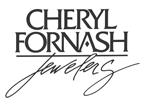Diamond Cut
A diamond's cut is considered to be the most important of the four Cs. It is important to understand how a diamond's proportions and the relationship between them can affect its brilliance, fire, and scintillation.

Ideal Cut Diamond
Cut, more than any other quality aspect, gives the diamond its sparkle. A diamond gets its brilliance and scintillation by cutting and polishing the diamond facets to allow the maximum amount of light that enters through its top to be reflected and dispersed back. When all the angles are correct, the light that enters is dispersed back through the diamonds top facets.
Inferior Cut Diamonds
Most diamonds are "spread" in their cutting to retain maximum weight from the original rough. A heavier diamond will result, but so does a dramatic sacrifice of potential fire and brilliance. The width and depth have the greatest effect on how light travels within the diamond, and how it exits in the form of brilliance.

Shallow Cut Diamonds
When a diamond is cut too shallow, light leaks out of the bottom, brilliance is lost and the diamond appears watery, glassy and dark. A diamond with these characteristics is referred to as a "fisheye".

Deep Cut Diamonds
When a diamond is cut too deep, light leaks out of the sides, brilliance is lost and the center of the diamond will appear to be dark. A diamond with these characteristics is referred to as a "nailhead". A diamond cutter spends years mastering his craft, learning how best to cut a rough diamond to achieve the ultimate cut with the fewest imperfections and the least loss of carat weight. The better the cut, the more valuable the diamond.

Diamond Proportions
Experts express differing opinions on the best table size (the diameter of the largest facet on the top of the stone) and the best depth for a diamond, because these factors alone are not sufficient to accurately judge its cut. Other factors - crown angle, girdle thickness, pavilion depth-percentage (the ratio of depth to girdle diameter), culet size, polish and symmetry - also play a role in judging a diamond's overall cut quality. A diamond's cut is graded by several measurements. Its depth percentage (a measurement of the height vs. the width of the stone) and its table percentage (a measurement of the diameter of the top facet of the stone vs. the stone's average width) are two key factors in determining the quality of a diamond's cut. These percentages are detailed on the GIA Gem Trade Laboratory Diamond Grading Report that accompanies every loose diamond from Cheryl Fornash.

Polish & Symmetry
Although polish and symmetry are graded under 10X magnification they can both have an effect on the overall appearance of a diamond. Polish refers to the quality of the diamond's surface and includes such features as nicks, polish lines and abrasions. Symmetry refers to the exactitude of the shape and alignment of the facets.
Some of the symmetry characteristics of round diamonds are listed below:
The polish and symmetry grades are listed in each diamond detail page and within the AGSL or GIA diamond grading report. AGSL grades polish and symmetry as ideal (ID), excellent (EX), very good (VG), or good (G). GIA graded diamonds will have polish and symmetry grades of excellent (EX), very good (VG), or good (G).
Holloway Cut Advisor
If you are interesting in purchasing a round brilliant diamonds, and Cheryl Fornash is selecting diamonds to show you, she uses the Holloway Cut Advisor tool to find the best-looking diamonds possible. This is just another step she goes through in the process of selecting the best diamonds to present to you. The Holloway Cut Scale Advisor, or HCA for short, is a tool that analyzes the proportions for round brilliant diamonds and estimates the diamonds’s potential fire, scintillation, light return and how large it looks for its weight. After analyzing the proportions, the HCA will rank the diamond on a scale from 0 to 10, with 0 being the best number possible. The number corresponds to a diamond’s cut with 0-2 as excellent, 2-4 as very good, 4-6 as good, 6-8 as fair and 8-10 as poor. Think of the HCA as a second opinion, if both GIA and HCA give a diamond an excellent cut, you can be assured you are getting a great looking diamond.


